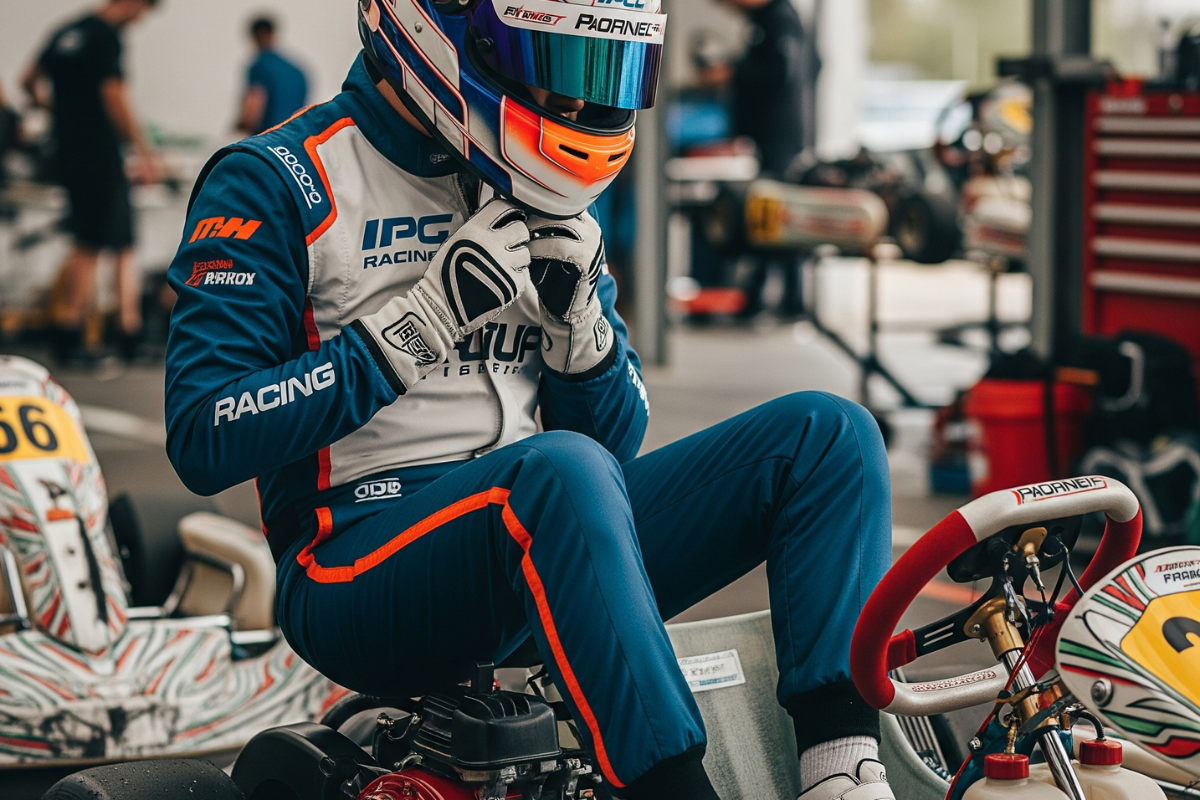Go-karting. The word itself conjures images of speed, tight turns, and the thrill of competition. For many, it’s an accessible entry point into motorsports, offering an adrenaline rush without the complexities and costs of professional racing. However, beneath the excitement lies a crucial, often overlooked, aspect: safety. Before you even think about hitting the throttle, understanding and prioritizing karting safety is absolutely paramount. This isn’t just about avoiding a minor bump; it’s about protecting yourself and others from potentially serious injury. This comprehensive guide will delve into every facet of karting safety, from essential gear to track etiquette and emergency protocols, ensuring your time on the asphalt is not only exhilarating but also secure.
The Unseen Heroes: Essential Safety Equipment
Your first line of defense on any karting track is your personal protective equipment (PPE). These items aren’t optional accessories; they are vital components designed to absorb impact, prevent abrasions, and shield you from potential hazards.
1. The Helmet: Your Cranial Commander
Undoubtedly the most critical piece of safety gear, a helmet protects your most vital organ: your brain.
- Why it’s Crucial: In a sport where speeds can reach significant levels and impacts can occur, a helmet dissipates kinetic energy from a crash, preventing skull fractures and concussions. It also shields your face from debris and provides a clear field of vision.
- What to Look For: Always choose a helmet with Snell, FIA, or ECE certification. These standards ensure the helmet has undergone rigorous testing. Look for a snug fit – it should be tight enough not to move when you shake your head but comfortable enough not to cause pain. Full-face helmets offer the most comprehensive protection, covering the entire head, face, and chin. The visor should be clear and scratch-free.
2. The Racing Suit: Your Protective Second Skin
More than just a stylish uniform, a karting racing suit provides vital body protection.
- Why it’s Crucial: In the event of a slide or roll-over, the suit protects your skin from road rash and abrasions. Many suits also feature padding in vulnerable areas like shoulders and elbows. Importantly, many are made from fire-resistant materials, offering precious seconds of protection in case of a fuel or engine fire.
- What to Look For: Ensure the suit fits well, allowing full range of motion without being baggy. Look for CIK-FIA homologation, which signifies adherence to international karting safety standards. Good ventilation can also be a plus for comfort during long sessions.
3. Rib Protector: Guarding Your Core
Often overlooked by beginners, a rib protector is an indispensable piece of gear.
- Why it’s Crucial: Karting seats are rigid, and the forces encountered during cornering and impacts can place immense strain on your ribs and internal organs. A rib protector absorbs and distributes these forces, preventing painful bruising or even fractures.
- What to Look For: Choose a protector that fits snugly around your torso without restricting breathing. It should have a hard outer shell and energy-absorbing foam on the inside.
4. Gloves: Grip and Protection
Your hands are constantly working the steering wheel, and karting gloves offer more than just comfort.
- Why it’s Crucial: They protect your hands from blisters and calluses caused by gripping the wheel. More importantly, they offer impact protection for your knuckles and palms, and provide superior grip on the steering wheel for precise control.
- What to Look For: Look for gloves with reinforced palms and fingers for better grip and durability. External seams often enhance comfort.
5. Shoes: Pedal Feel and Foot Defense
Forget your everyday sneakers; karting-specific shoes are designed for performance and safety.
- Why it’s Crucial: Karting shoes feature thin, sensitive soles that allow for precise pedal modulation, crucial for delicate throttle and brake control. Their narrow design prevents your feet from getting snagged, and their construction often includes ankle support and fire-resistant materials.
- What to Look For: Prioritize excellent pedal feel, ankle support, and a lightweight, breathable design.
6. Neck Brace/Collar: Protecting Your Spine
Protecting your neck is just as important as protecting your head.
- Why it’s Crucial: In an impact, a neck brace or collar helps limit the movement of your head relative to your torso, significantly reducing the risk of whiplash or more severe spinal injuries.
- What to Look For: Neck braces offer more comprehensive protection by connecting to your helmet and spreading forces, while neck collars provide basic support. Many tracks, especially for competitive racing, mandate the use of specific neck support devices.
The Language of the Track: Understanding Flag Signals
On the karting track, communication isn’t verbal; it’s visual. Flag signals are the universal language used by marshals and race control to convey critical information to drivers. Misinterpreting these signals can lead to dangerous situations, penalties, or even accidents.
- Yellow Flag (Waved/Stationary): Caution! Danger Ahead!
- Waved: Immediate and significant danger in the section you are entering (e.g., spun kart, crash). Slow down, prepare to stop, no overtaking.
- Stationary: Danger further ahead on the track. Reduce speed, be aware, no overtaking.
- Green Flag: All Clear! Race On!
- Signifies the track is clear and normal racing conditions have resumed. You can now accelerate and overtake.
- Red Flag: Stop Immediately!
- Displayed for serious incidents requiring the immediate halt of the session. Slow down safely and proceed to a designated safe area or pits. No overtaking.
- Blue Flag: Faster Kart Approaching!
- Shown to a slower driver to indicate a faster kart is about to lap them. Allow the faster kart to pass safely and quickly.
- Black Flag: Return to Pits (Penalty/Disqualification)
- Shown with your kart number, it means you must return to the pits immediately for a penalty, mechanical issue, or disqualification.
- Black Flag with Orange Circle: Mechanical Problem!
- Indicates your kart has a mechanical issue that needs immediate attention. Return to pits safely.
- White Flag: Last Lap!
- Signals that the current lap is the final lap of the race or session.
- Checkered Flag: Race Over!
- Indicates the end of the race or session. Slow down safely and proceed to the designated exit or pits.
The Golden Rules of Safe Karting: Beyond the Gear
Beyond the physical equipment and flag signals, a set of golden rules govern safe and responsible karting behavior. Adhering to these principles is crucial for preventing incidents and ensuring a positive experience for everyone.
1. Attend the Safety Briefing – Every Single Time
Never skip the pre-session safety briefing. Even if you’re a veteran, track-specific rules, new procedures, or changes in layout can be introduced. This is your primary source of immediate safety information.
2. Prioritize Safety Over Speed
This is the fundamental principle. While the urge to go fast is strong, never compromise safety for speed. Drive within your limits and the limits of the kart. Pushing too hard leads to mistakes and accidents.
3. Always Maintain Control of Your Kart
Your kart is powerful. Drive smoothly and predictably. Avoid sudden, erratic movements, aggressive swerving, or abrupt braking that could cause you to spin or collide with others.
4. Respect Other Drivers and Their Space
The track is shared. Give other drivers ample space, especially when cornering or in close quarters. Intentional contact, blocking, or reckless overtaking is dangerous and unacceptable. Remember, everyone is there to have fun.
5. No Bumping or Intentional Contact
Karting is a non-contact sport. Deliberately bumping or ramming other karts is strictly forbidden. Such actions can cause serious injuries, damage, and will result in immediate disqualification.
6. Understand and Obey Track Limits
Stay within the clearly marked track limits. Going off-track can bring dirt onto the racing surface, making it slippery for others, or put you in a dangerous position upon re-entry.
7. Be Aware of Your Surroundings (Situational Awareness)
Always keep an eye on what’s happening around you. Regularly check your mirrors (if equipped) and use your peripheral vision. Anticipate potential hazards like a spinning kart or debris.
8. Listen to and Obey Marshal Instructions
Track marshals are there for your safety. Their instructions are final and must be followed immediately and without question. They have the best view of the track and are trained to manage incidents.
9. Smooth and Predictable Driving
Consistent and predictable driving helps everyone. Avoid sudden changes in speed or direction without clear reason. This allows other drivers to anticipate your moves and avoid collisions.
10. Safe Entry and Exit from the Track
Always enter and exit the track slowly and carefully, following designated paths. Do not stop on the main racing line. If you have a mechanical issue, try to pull off the track into a safe zone and signal to marshals.
11. Pre-Drive Checks (If You Own a Kart)
If you own your kart, perform essential pre-drive checks: tire pressure, brake functionality, steering responsiveness, fuel and oil levels, and check for any loose parts. If renting, quickly visually inspect the kart for obvious issues and report them to staff.
Why Safety Matters: Beyond the Adrenaline
The allure of karting lies in its speed and competitive nature. However, true enjoyment and longevity in the sport come from a deep respect for its inherent risks and a commitment to safety. Every rule, every piece of gear, and every flag signal is designed with your well-being in mind.
Ignoring safety protocols not only puts you at risk but also endangers fellow karters, track staff, and spectators. It can lead to severe injuries, costly damage, and a tarnished reputation for the sport.
By internalizing the information in this guide – understanding your equipment, learning the language of the flags, and adhering to the golden rules of the track – you transform yourself into a responsible and confident karter. You’ll be able to push your limits, enjoy the thrill, and return home safely, ready for your next exhilarating session. So, before you speed, make sure you know everything about karting safety. Your life, and the fun of others, depends on it.

Ramon Splinter is a passionate go-kart enthusiast and expert who shares valuable tips and insights on Zyorb, a blog dedicated to karting enthusiasts. With years of experience on the track, he specializes in helping beginners and seasoned drivers improve their skills, optimize their karts, and master racing strategies. His articles combine technical knowledge with practical advice, making go-karting more accessible and exciting for all.

